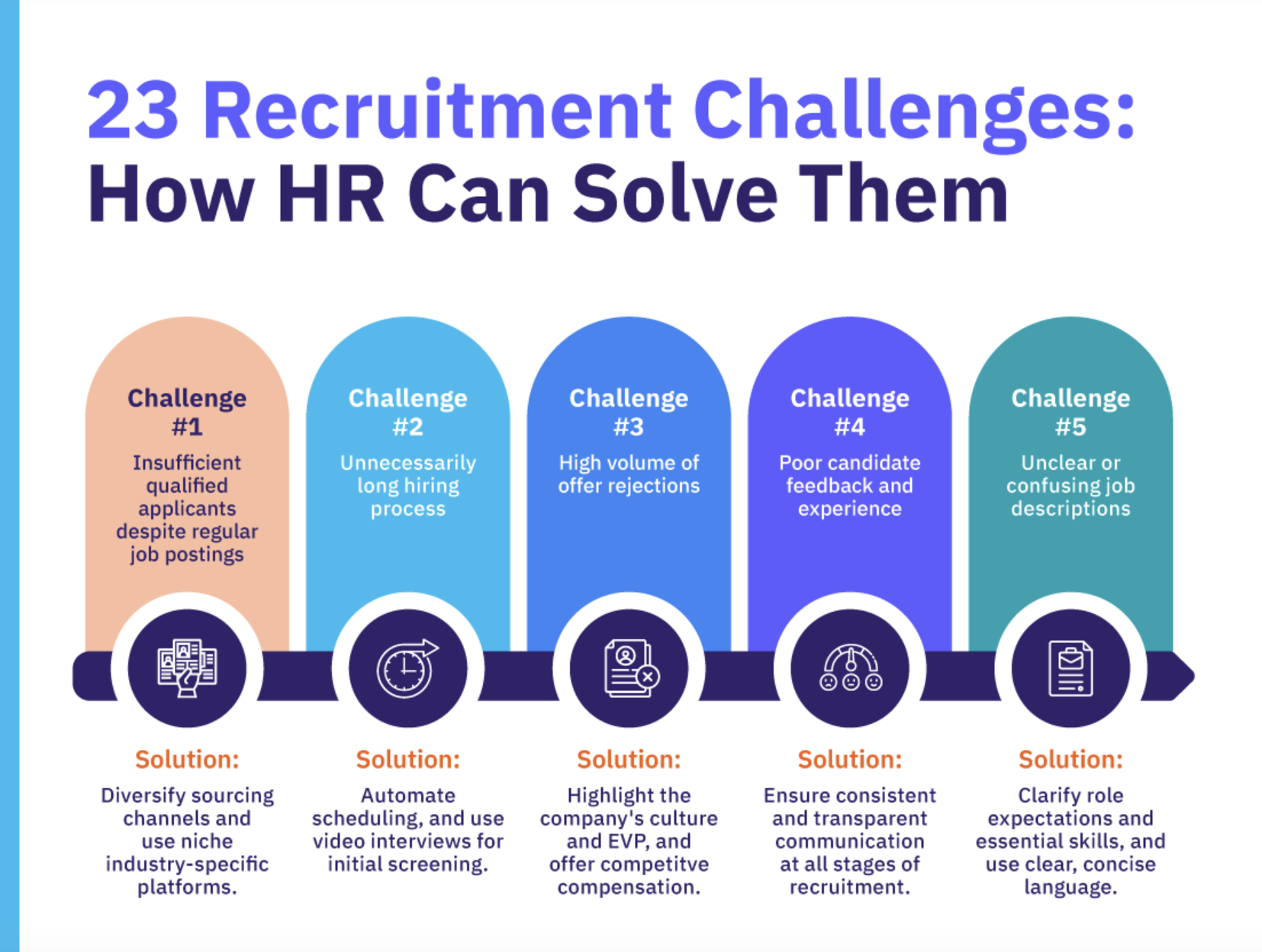By: Nicole Lombard
A healthy talent pipeline is a valuable asset — it forms the foundation for smooth operations, market responsiveness, and innovation, all of which are necessary to drive sustained business growth. However, organizations worldwide are still facing talent scarcity.
Beyond simply filling vacancies, HR leaders must identify and proactively resolve the recruitment challenges hindering their organizations’ hiring effectiveness and market competitiveness. This article discusses the importance of addressing recruitment challenges and HR’s role in doing so, and presents 23 such challenges and how to solve them.
Why address recruitment challenges?
Recruitment issues don’t just remain in HR — they affect every team and hurt your organization’s bottom line. Here are other key reasons to address them promptly and proactively:
Business growth and employee morale: Recruitment issues can lead to stalled projects and operational strain, which delays growth and raises costs. Understaffing can also result in greater workloads that negatively impact team morale.
Quality of hire: When roles stay open too long, there’s pressure to hire fast. This often leads to poor hiring decisions, which can cost up to 200% of an individual’s annual salary, disrupt teams, and increase turnover.
Hiring difficulties: The talent pool is competitive, and finding people with the right mix of skills is tricky. In fact, skills mismatches slow down progress and place pressure on both employers and employees.
Employer reputation: Over 75% of job seekers check a company’s reputation before applying, and 69% say they’d turn down an offer from a company with a bad reputation — even if they didn’t have other options.
You must address these challenges upfront to attract top talent and optimize your hiring process. This proactive approach not only improves retention and reduces turnover,but it also safeguards your employer brand for long-term success.
HR’s role in solving recruitment challenges
As an HR professional, you play a key role in shaping your company’s talent strategy, solving recruitment challenges, and helping the business grow. When addressing recruitment challenges, you’ll likely have to take on the following responsibilities”
Lead the recruitment strategy, process, and execution
You own the full recruitment lifecycle, from planning to onboarding. This means building a hiring strategy that supports business goals, creating efficient processes, and guiding candidates through each stage. You define job needs, manage offers, and make sure everything runs smoothly and consistently.
Create fair, inclusive, and effective hiring practices
You’re also responsible for making hiring fair and inclusive. This includes removing bias from job ads, interviews, and evaluations. Focusing on Diversity, Equity, Inclusion, and Belonging (DEIB) helps your company meet legal requirements, strengthens your workforce, and shows your organization is ethical and future-focused.
Coordinate with hiring managers, use the right tech, and adapt to trends
You must work closely with hiring managers to align on role expectations and timelines. You also need to choose the right tech — e.g., applicant tracking systems (ATS) or AI tools — to streamline hiring and obtain better data. Being able to spot and react to workforce trends quickly can help you give your company a competitive edge.
Manage candidate experience, internal alignment, and compliance
Additionally, you must manage the candidate experience, ensuring it’s efficient, respectful, and transparent. Internally, you must keep everyone — from hiring teams to leadership — on the same page. At the same time, make sure all your hiring practices adhere to labor laws to reduce the risk of compliance issues.
23 recruitment challenges and how to solve them
For every problem, there is a specific and actionable solution. Use this cheat sheet to help you overcome your pressing recruitment challenges:
1. Insufficient qualified applicants despite regular job postings
Challenge: Your job postings aren’t attracting candidates with the right skills or experience, leading to a shallow talent pool.
Solution: Diversify your sourcing channels beyond traditional job boards and use niche industry-specific platforms. You can explore professional social networks (e.g., LinkedIn or GitHub for tech roles) and invest in employee referral programs, which often yield high-quality, pre-vetted candidates.
2. Unnecessarily long hiring process
Challenge: A drawn-out recruitment process leads to candidate drop-off and the loss of top talent, as your more agile competitors snatch them up.
Solution: Streamline your workflows by automating scheduling, using video interviews for initial screening, and reviewing each step of your process to eliminate unnecessary stages or redundant approvals. Aim for improved efficiency without having to sacrifice quality.
3. High volume of offer rejections
Challenge: Qualified candidates are declining your job offers, indicating a mismatch in expectations, or your competitors having a greater competitive advantage.
Solution: Improve your employer branding by showcasing company culture and employee value proposition (EVP). Conduct regular salary and benefits benchmarking to competitive offers, and personalize offer discussions to address candidates’ specific needs and development goals.
4. Poor candidate feedback and experience
Challenge: Candidates often feel ignored, frustrated, or disrespected during the hiring process, which can damage your employer brand and put off future applicants.
Solution: Ensure consistent and transparent communication at all stages of recruitment. Provide timely updates, personalize interactions, and offer constructive feedback to unsuccessful candidates. Feedback surveys for both successful and unsuccessful applicants will shed light on areas for improvement.
5. Unclear or confusing job descriptions
Challenge: Vague or generic job descriptions tend to attract unqualified applicants, leading to confusion and wasted time for both candidates and hiring managers.
Solution: Collaborate closely with hiring managers and department heads to clarify role expectations, essential skills, and daily responsibilities for each job description. Use clear, concise language throughout all descriptions, and focus on intended outcomes in addition to listing tasks.
6. Lack of diversity in your candidate pool
Challenge: Your applicant pool lacks representation across demographics, limiting diverse perspectives that can drive innovation or reflect your customer base.
Solution: Use blind résumé reviews to minimize unconscious bias and broaden sourcing to include diverse professional networks and communities. Additionally, ensure minority representation on your interview panels and focus on DEIB messaging in your employer branding and job ads.
7. Competition from other companies
Challenge: Your competitors are aggressively pursuing high-demand talent, making it difficult for your company to stand out.
Solution: Develop a compelling EVP that highlights your organization’s standout qualities beyond salary (e.g., growth opportunities, work-life balance, or social impact). Actively promote this across all touchpoints, and nominate employee ambassadors to share their positive work stories on social media.
8. Budget constraints
Challenge: Limited financial resources restrict your ability to invest in premium job boards, recruitment marketing, or advanced tools.
Solution: Focus on cost-effective strategies, like optimizing your career page for SEO, using free social media channels, and maximizing employee referral bonuses and incentives. Additionally, you can track top applicant sources and prioritize tools that offer significant ROI.
9. Difficulty in assessing soft skills
Challenge: Traditional interviews often fail to effectively evaluate crucial soft skills, such as teamwork, adaptability, and problem-solving.
Solution: Incorporate behavioral interview questions, scenario-based assessments, and peer evaluations into your process. Use structured interviews to ensure consistency and objectivity in assessments, and involve two or more interviewers. This allows the others to observe while one interviewer engages with the candidate.
10. Candidate ghosting
Challenge: Candidates disappear mid-process or after accepting an offer, leaving your organization with unexpected vacancies and wasted effort.
Solution: Maintain continuous, engaging communication throughout the recruitment process, build rapport with candidates, and update them promptly and clearly. This can minimize candidate ghosting, as it often happens due to a poorly managed recruitment process, or recruiters being too impersonal.
11. Internal communication breakdowns
Challenge: Misalignment between HR and hiring managers or department heads leads to delays, duplicated efforts, and a disjointed candidate experience.
Solution: Establish clear communication protocols, schedule regular check-ins, and use shared platforms to track candidate progress. You should also promote a culture of collaboration and mutual accountability to ensure all relevant parties are on the same page at all times.
12. Legal and compliance risks
Challenge: Navigating complex labor laws, anti-discrimination regulations, and data privacy requirements can expose your company to legal liabilities.
Solution: Stay up-to-date on all relevant employment laws. Implement standardized, legally vetted processes, and train all your organization’s hiring personnel on compliance best practices. Finally, consult legal counsel regularly and proactively to keep up with legislative changes.
13. Ineffective onboarding
Challenge: A poor onboarding experience can increase new hire turnover, resulting in wasted time and effort in recruitment and higher recruitment costs.
Solution: Create a structured, supportive onboarding program that extends well beyond each new hire’s first week. Focus on cultural integration, help new staff set clear goals, provide necessary resources and mentorship, and ensure all newcomers can function effectively in their respective roles.
14. High turnover of new hires
Challenge: New employees tend to leave within their first year, indicating a possible disconnect between reality and promises made during recruitment.
Solution: Conduct regular stay interviews with new hires to gather feedback on their experience and identify any systemic problems so you can address issues promptly. Provide realistic job previews during the recruitment process. For instance, describe what a new hire can expect from a typical work day to help manage their expectations.
15. Lack of clear hiring manager expectations
Challenge: Hiring managers have vague or conflicting views of the ideal candidate, prolonging the search and leading to frustration and inefficiency.
Solution: Implement a structured kick-off briefing process for HR, hiring managers, and department heads to align on role requirements, candidate profiles, interview stages, and decision-making criteria before your search begins. This helps prevent confusion and conflict from the start.
16. Outdated recruitment technology
Challenge: Relying on manual processes or outdated systems can slow down recruitment, limit data insights, and frustrate both HR and candidates.
Solution: Invest in modern Applicant Tracking Systems (ATS), CRM tools, and AI-powered solutions that automate tasks, provide analytics, and enhance candidate engagement. AIHR’s Artificial Intelligence for HR Certificate Program can teach your HR team how to streamline the recruitment process.
17. Measuring recruitment efforts’ ROI
Challenge: Difficulty quantifying your recruitment strategies’ effectiveness and ROI can make it hard to justify budgets, improve performance, and make informed hiring decisions.
Solution: Implement clear recruitment metrics (e.g., time to hire, cost per hire, source of hire, or quality of hire) and use data analytics to track performance, identify bottlenecks, and demonstrate value to leadership.
18. Global hiring complexities
Challenge: Expanding your talent search globally introduces complexities related to local labor laws, cultural nuances, and logistical hurdles.
Solution: Partner with a global Employer of Record (EOR) service provider, or hire a local HR consultant. Additionally, be sure to develop culturally sensitive recruitment materials and adapt your interview processes to suit relevant local norms.
19. Attracting passive candidates
Challenge: You may struggle to attract passive candidates as they aren’t actively job hunting and need a strong, personalized reason to consider switching roles.
Solution: Develop a strong talent-nurturing strategy through content marketing, professional networking, and targeted outreach. Build relationships with potential candidates well in advance of a vacancy arising, and consider using headhunters for high-priority roles.
20. Specific skills gap for roles
Challenge: The market simply doesn’t have enough candidates with the highly specialized or emerging skills your company needs.
Solution: Explore internal upskilling and reskilling programs, invest in apprenticeships, or consider alternative talent pools. These can include recent graduates, freelancers, or career changers you can train. Alternatively, consider global candidates who are willing to relocate or work remotely.
21. Managing application volume
Challenge: An overwhelming number of applications (many of which come from unqualified candidates) consumes excessive HR time and resources.
Solution: Use AI-powered résumé screening tools to filter candidates based on predefined criteria, and implement clear pre-screening questions. At the same time, consider introducing pre-interview assignments, and optimize your job descriptions to deter unqualified applicants.
22. Lack of internal mobility programs
Challenge: Overlooking internal talent for new roles leads to external hiring, increased costs, and missed opportunities for employee growth and retention.
Solution: Develop formal internal job posting processes, create talent marketplaces, and encourage managers to identify and develop employees for future roles within your organization. Use an effective internal job posting template to support you in this process.
23. Ineffective interview techniques
Challenge: Unstructured or biased interview approaches typically lead to inconsistent evaluations and poor hiring decisions.
Solution: Implement structured interview guides with standardized questions and scoring rubrics. Train interviewers on behavioral interviewing techniques and make them aware of unconscious bias, so they know what to avoid asking or doing. This also helps hiring managers make objective, fair hiring decisions.
Handling recruitment challenges: HR best practices
To fix recruitment issues, identify what’s not working and apply these best practices to your day-to-day HR work:
Track recruitment metrics to improve results
Regularly monitor time to hire, cost per hire, source effectiveness, offer acceptance, and retention. Use the data to find process slowdowns, improve efficiency, and show leadership your recruitment ROI. For example, if your time to hire is long, data can help pinpoint where delays occur and what’s causing them.
Train hiring managers to spot bias and interview better
While hiring managers must be able to make sound hiring decisions, it’s unwise to expect them to know how to conduct interviews without unconscious bias. Train them on behavioral interviews, active listening, and how to spot bias. This can help create a consistent, fair approach across teams and departments.
Use HR tech to save time and boost reach
Use an ATS to manage applications, automate tasks, and track progress. AI tools can sort resumes faster and highlight top candidates. Recruitment marketing tools help promote your employer brand and enable your organization to attract both active and passive talent across digital platforms.
Standardize and update your recruitment process
Create a clear, repeatable workflow that defines roles, timelines, and decisions at every step. This will minimize confusion and maximize fairness and consistency. At the same time, make sure you review and update this process regularly (e.g., every quarter or year), based on data, feedback, and hiring needs.
Build pipelines for future roles
Don’t just hire for open roles — prepare for future positions. Identify key roles and build relationships with potential candidates early. This might include talent communities, university outreach, or nurturing passive leads. A full pipeline helps you speed up the hiring process when the time comes.
Watch labor market trends and adjust your strategy
Stay alert to changing skills, candidate expectations, and industry shifts, so you can adapt your sourcing strategy using market insights and predictive data. Partner with schools and industry groups, and update your employer brand and EVP to match the needs and requirements of top talent.
To sum up
HR professionals face many recruitment challenges, including fierce competition for top talent, evolving candidate expectations, skills gaps, and outdated or ineffective internal processes. All these hiring roadblocks can impact growth, increase costs, and drain morale.
Recruitment challenges are unavoidable but not unmanageable. By addressing problems head-on, building strong processes, and staying in tune with the market, you’ll not only attract better candidates but also strengthen your company’s ability to grow and compete.





